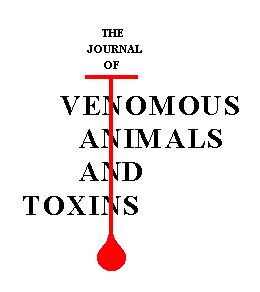THESIS: M.O. Domingos submitted this dissertation for the degree of Master of Immunology publicly examined at the Institute of Biomedical Science of the University of São Paulo, São Paulo, Brazil in 1992.
Advisor: Professor Ivan Mota
ABSTRACT. Envenoming by snakes of the genus Bothrops induces conspicuous tissue damage to victims. The effects of venom injection are characterized by local necrosis, local hemorrhage and swelling both in man and in experimental animals. The venom also induces an immune response. The isotype and specificity of antibodies produced by patients bitten by B. jararaca and submitted to serotherapy were studied. The level of IgG anti-B. jararaca venom showed large individual dispersion being first detected 18 days after the bite and increasing up to 80 days after the bite. IgM antibodies were detected earlier than IgG antibodies, decreased to normal level and disappeared about 20 days after the bite. Secondary response was characterized by a fast and higher IgG antibody response with no apparent change in the IgM response. The immunoblotting tests showed that the specificity of human anti-B. jararaca IgG venom was very heterogeneous, each patient recognizing different fractions in B. jararaca venom. The heterologous antivenom persisted in serum up to 21 days after serotherapy. The results obtained using mice injected with venoms showed that after intradermal injection the venom was released very slowly from the tissues at the injected site, and 24 hours later a significant amount of venom still remained at the injected site. In contrast, venom concentration in blood increased up to 3 hours but cleared 16 hours later. After intradermal injection of antivenom at a close skin site, no venom was detected either in skin or blood 3 hours later. Intravenous injection of antivenom did not induce a significant reduction of local venom levels. When antivenom was administered intradermally at site of venom injection, a significant reduction in the local hemorrhagic lesions occured, provided that the antivenom was injected either immediately or no more than 5 minutes after venom injection. Necrosis was reduced to about 50% when the antivenom was injected intradermally, next to the venom injection site, up to 30 minutes after envenoming. These same results were obtained when the antivenom was injected intravenously. In spite of the relative ineffectiveness of the antivenom in neutralizing the venom local effects, it was very effective in neutralizing the venom coagulation action when the antivenom was injected either intradermally or intravenously. After intramuscular injection venom clearance from the muscle and skin into blood was very fast. However, the amount of venom found in the skin was always higher than that in the muscle. No venom was detected in the lungs, liver, spleen or heart. Low venom concentration was detected in the kidneys.
CORRESPONDENCE TO:
M.O. DOMINGOS - Laboratório de Imunopatologia - Instituto Butantan - Av. Vital Brazil 1500 - CEP 05503-900 - São Paulo - SP - Brasil.
Publication Dates
-
Publication in this collection
08 Jan 1999 -
Date of issue
1995


